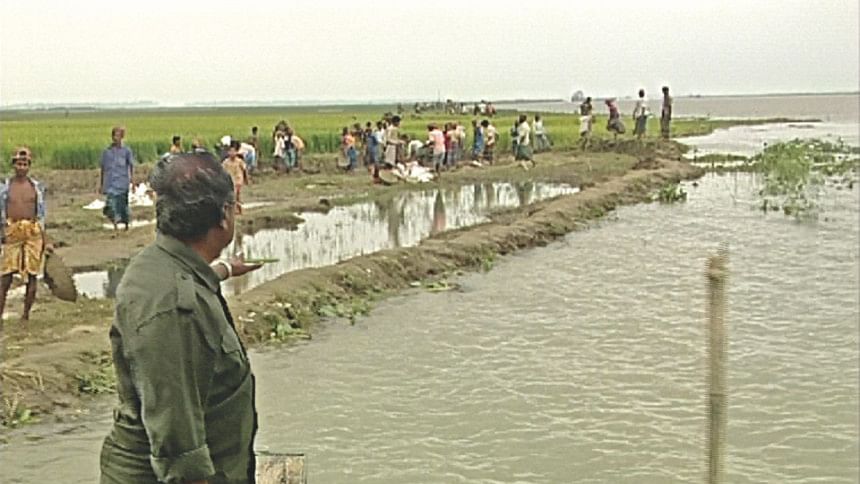Nature turns her back on Haor people

Bangladesh is a country of six seasons. Probably, nowhere in the world is there such a great diversity of seasons in so small a geographical location. Since my childhood till ten or fifteen years back, we could feel the changes in the seasons, in nature. Now, it's very difficult to feel the difference in the nature and environment and even weather patterns in one single season. I can't remember when I felt the true ambience of hemanta (autumn). Generally, we see the hot and humid weather, rain and then a little bit of winter -- that's all. Everything has turned topsy-turvy.
As I have been roaming across the country since the early 80s, I could see the changes from very close. The nature has changed, and finally, seasons are no longer that much distinct.
Many days back, I watched a film, "The man who saw tomorrow". Later on, I watched "Day after tomorrow" and then "2012". All these fantasy stories depict the changes in the climate and their extreme effects, but these imaginary screenplays some way or other give me the hint that many of the stories are turning out to be real now. During my work across the world from Africa, Asia and America -- I saw the impact of climate change and it's happening pretty fast. A small town in Newfoundland, Canada, has a new visitor- one of the biggest icebergs (64-metre high) of the season.
These information and images remind me of the famous anthropologist Claude Lévi-Strauss' comment, “The world began without the human race and will certainly end without it.”
"Since the journey of earth, humankind tried to establish its dominance. Advanced technologies came in between for this dominance. A peculiar boast is triggering our desire and we started believing we can live without nature. We need to stay away from these kinds of bizarre concepts," said David Suzuki, Japanese environmentalist in a nature documentary, I watched couple of years back. The most astonishing quote was from the writer of Biomimicry, Janine Benius, "If January is the first and December is the last month of the year in the calendar, then, according to the earth's age, we're standing at the end of its life span, which means December."
These thoughts and observations seem somewhat real to me considering the drastic changes in nature.
The earth is not anymore the earth we used to know. Clear sky, fresh air, fertile soil and a friendly climate -- nothing is there any longer. A whole lot has changed. Only sunrise and sunset has remained unchanged. The heat, temperature, warming, biosphere and cold in the Himalayas or the snowy nature in the polar regions --nothing seem to be on track. The natural regulations in the deepest regions of the oceans and over the ground -- nothing is functioning properly. The land and the deep structures of soil isn't working right as well.
And, Bangladesh is also suffering the changes. Salinity has increased and the southern salinity may travel to the Jamuna river and its surrounding regions. More hailstorms and 152% increase in rainfall in March and a very short winter indicate all the unexpected changes of climate.
Now, it's all about the despair and havoc in haor region of Bangladesh. The recent flash floods in the haor regions in north-eastern Bangladesh demonstrate the threat of climate change that looms large over Bangladesh. It also indicates our nation's lack of awareness of climate change and its impact on haors and other disaster prone areas. In six districts comprising large haor areas -- Habiganj, Netrakona, Sunamganj, Brahmanbaria, Kishoreganj and Moulvibazar, farmers suffer massive destruction of paddy fields. In Sunamganj, farmers cultivated Boro paddy on over 2,23,850 hectares of land this year. Already, 82% of the rice is ruined, says government accounts but farmers claim it's 90%. Lastly, Shanir Haor, locally known as 'rice mine', too went under water, submerging Boro paddy on 22,000 acres of land. Flash floods submerged around 48,670 out of 184,320 hectares of land targeted for Boro cultivation in eight upazilas of Netrakona, said Bilash Chandra Pal, deputy director of the Department of Agriculture Extension of the district.
Farmers cultivated Boro paddy on 4.5 lakh hectares of haor land this year. District agricultural offices say around 2.5 lakh hectares of land was submerged in the flash floods, 87 embankments were damaged and all the 142 haors went under water by the time I'm writing this article. The flash floods have reportedly caused damage to crops worth over Tk 4,000 crore. The Haor Advocacy Platform has come to disclose this, considering the loss of one million tonnes of rice, 2000 tonnes of fish and 11,305 tonnes of livestock feed. However, the loss is likely to go up to 10,000 crore taka.

Flash floods are not a new phenomenon for farmers of the haor regions but it usually come after they harvest a major portion of the Boro crops by mid-April. But this year, they were completely taken by surprise as the early floods inundated their croplands from late March. It also affected fish, ducks and cattle. The images on the newspapers and videos on TVs were heartbreaking.
These early flash floods in haor areas is the result of climate change which is having a bad impact on agricultural productivity, natural fish breeding, land use practice, lifestyles and livelihoods in the haor areas.
Dear readers, we have saline, drought and submergence tolerant rice varieties, but it's time to check the sustainability of these varieties and our policymakers must foresee the disasters and its impact on people and biodiversity and plan accordingly. Or else, the entire food chain will collapse in these affected regions. For example, from the next year farmers should be able to harvest their paddy from the beginning of March instead of the end of the month, since we have seen how the flash floods starting from March 27, have destroyed everything. They must get a short-term variety of rice so that they can take home their golden crops. For example, monga, a near-famine situation in a few northern districts, has been prevented with the help of a short term rice variety that farmers harvest in only three months.
Our scientists and policymakers need to see the future and help farmers to overcome their troubles. If they can come up with a solid plan and right technology, farming and biodiversity of the haor and other regions of our country will be saved.
Dear readers, when this article will be published the facts and figures in the haor areas will presumably deteriorate. The whole world is one country -- that's how the global citizen should believe. The government should be steadfast to resolve the river and water issues with our neighbouring country. Or, everything will be too late. And, we do not want our farmers to suffer like this.
We must become literate about climate change and its effects and take effective measures accordingly. We must comprehend the impacts of climate change to combat it effectively, going beyond the traditional thought of getting aid and grants from international organizations and rich countries. We have to understand why the fate of haor can affect the fate of Bangladesh.

 For all latest news, follow The Daily Star's Google News channel.
For all latest news, follow The Daily Star's Google News channel. 



Comments